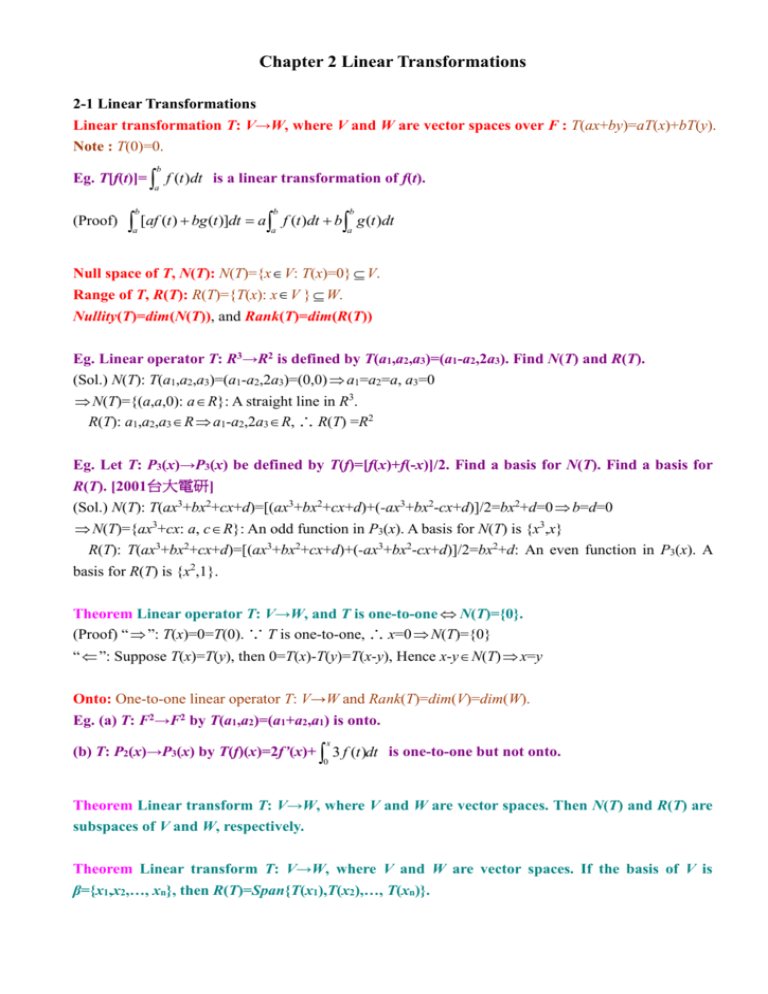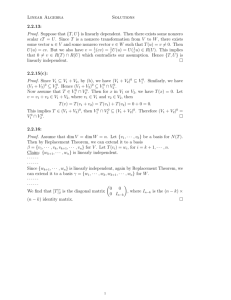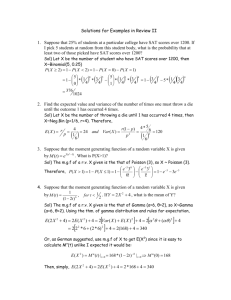Chapter 1 Vector
advertisement

Chapter 2 Linear Transformations
2-1 Linear Transformations
Linear transformation T: V→W, where V and W are vector spaces over F : T(ax+by)=aT(x)+bT(y).
Note : T(0)=0.
b
Eg. T[f(t)]= f (t )dt is a linear transformation of f(t).
a
(Proof)
b
b
a
a
[af (t ) bg (t )]dt a
b
f (t )dt b g (t )dt
a
Null space of T, N(T): N(T)={x V: T(x)=0} V.
Range of T, R(T): R(T)={T(x): x V } W.
Nullity(T)=dim(N(T)), and Rank(T)=dim(R(T))
Eg. Linear operator T: R3→R2 is defined by T(a1,a2,a3)=(a1-a2,2a3). Find N(T) and R(T).
(Sol.) N(T): T(a1,a2,a3)=(a1-a2,2a3)=(0,0) a1=a2=a, a3=0
N(T)={(a,a,0): a R}: A straight line in R3.
R(T): a1,a2,a3 R a1-a2,2a3 R, ∴ R(T) =R2
Eg. Let T: P3(x)→P3(x) be defined by T(f)=[f(x)+f(-x)]/2. Find a basis for N(T). Find a basis for
R(T). [2001台大電研]
(Sol.) N(T): T(ax3+bx2+cx+d)=[(ax3+bx2+cx+d)+(-ax3+bx2-cx+d)]/2=bx2+d=0 b=d=0
N(T)={ax3+cx: a, c R}: An odd function in P3(x). A basis for N(T) is {x3,x}
R(T): T(ax3+bx2+cx+d)=[(ax3+bx2+cx+d)+(-ax3+bx2-cx+d)]/2=bx2+d: An even function in P3(x). A
basis for R(T) is {x2,1}.
Theorem Linear operator T: V→W, and T is one-to-one N(T)={0}.
(Proof) “ ”: T(x)=0=T(0). ∵ T is one-to-one, ∴ x=0 N(T)={0}
“ ”: Suppose T(x)=T(y), then 0=T(x)-T(y)=T(x-y), Hence x-y N(T) x=y
Onto: One-to-one linear operator T: V→W and Rank(T)=dim(V)=dim(W).
Eg. (a) T: F2→F2 by T(a1,a2)=(a1+a2,a1) is onto.
x
(b) T: P2(x)→P3(x) by T(f)(x)=2f’(x)+ 3 f (t )dt is one-to-one but not onto.
0
Theorem Linear transform T: V→W, where V and W are vector spaces. Then N(T) and R(T) are
subspaces of V and W, respectively.
Theorem Linear transform T: V→W, where V and W are vector spaces. If the basis of V is
β={x1,x2,…, xn}, then R(T)=Span{T(x1),T(x2),…, T(xn)}.
Eg. Linear operator L: R2→R3 is defined by L(x,y)=(x+y,x-y,x+2y) (a) Find a basis for the range
of L. (b) Is L onto? [1990 交大工業工程所]
1 1
x y
x
x
(Sol.) L( ) 1 1 x y
y 1 2 y x 2 y
1 1
1 0 0
(a) ∵ Rank ( 1 1) 3 , ∴ Choose the basis of R(L)= ( 0 ' 1 ' 0 ) . (b) R2→R3, ∴ No.
1 2
0 0 1
Eg. Linear operator T: R2→R2 is defined by T(1,0)=(1,4), T(1,1)=(2,5). (a) T(3,5)= ? (b) What is
the null space of T? (c) What is R(T)? (d) Is T one-to-one? (e) Is T onto? [1990 交大電子所]
a b x
(Sol.) T(x,y)=(ax+by,cx+dy)=
c d y
T(1,0)=(1,4) a=1, c=4, T(1,1)=(2,5) a+b=2, c+d=5 b=1, d=1
1 1 3 8
(a) T (3,5)
, or T(3,5)=(8,17)
4 1 5 17
1 1
(b) For the standard basis of R2, T
.
4 1
x y 0
x0
1 1 x x y 0
0
4 1 y 4 x y 0 4 x y 0 y 0 N(T)= {0}
(c) ∵ x+y, 4x+y R, ∴ R(T)=R2.
(d) ∵ N(T)={0}, ∴ Yes. (e) ∵ one-to-one and R2→R2, ∴ Yes.
Theorem Linear operator T: V→W, if V is finite-dimensional, then Nullity(T)+Rank(T)=dim(V).
[1999 台大電研]
(Pr oof ) Suppose dim( V ) n and x1 ,, x k : basis of N (T ) extend x1 ,, x k
to x1 , , x k , x k 1 , , x n : basis of V
It is desired to show that S T ( x k 1 ), , T ( x n ) is a basis for R(T ).
1. For 1 i k , T ( xi ) 0
2. R(T ) SpanT ( x1 ), , T ( x n ) Span( S ) SpanT ( x k 1 ), , T ( x n )
3. If T ( xi ) is linearly independent , k 1 i n, then the proof is complete.
n
biT ( xi ) 0
i k 1
n
n
i k 1
i k 1
T (bi xi ) T ( bi xi ), k 1 i n
ci F i k s.t.
n
k
i k 1
i 1
bi xi ci xi or
k
( c i ) x i
i 1
n
b x
i k 1
i
n
b x
i k 1
i
i
i
N (T ) Span( x1 ,, x k )
0
x1 , , x n is a basis (linear independent ), bi 0 i T ( xi ) is linearly independent
Eg. Let T: V→W be a one-to-one linear transformation and V be a finite-dimensional vector
space. Show that Rank(T)=dim(V). [台大電研類似題]
(Proof) T: V→W is one-to-one N(T)={0}, ∴ Nullity(T)=0 Nullity(T)+Rank(T)=Rank(T)=dim(V).
2-2 Matrix Representations and Coordinate (Basis) Transformations
In Matlab language, we can use the following instructions to find out the ijth-entry, the mth-row, and
the nth-column of a matrix:
>>A=[0,1,2;3,4,5]
A=
0
1
3
4
>>A(2,1)
ans =
3
>>A(2,3)
ans =
2
5
5
>>ROW1=A(1,:)
ROW1 =
0
1
>>COL1=A(:,2)
COL1 =
1
4
2
Matrix representation of a linear transformation: Linear transformation T: V→W, β={x1,x2,…,xn} is
a basis for V, γ={y1,y2,…,ym} is a basis for W, then ! aij F for i=1, 2,…, m and j=1, 2, …, n such
m
that T(xj)= aij y i
i 1
a11
a
A= 21
a31
a12
a 22
a32
T ( x1 ) a11 y1 a21 y2 a31 y3
for j=1, 2, …, n. That is, T ( x2 ) a12 y1 a22 y2 a32 y3 , and then
T ( x ) a y a y a y , etc.
3
13 1
23 2
33 3
a13
a 23
.
a33
Eg. Linear operator T: P3(R)→P2(R) by T(f)=f’, find T , where β, γ are the standard ordered
bases for P3(R) and P2(R), respectively.
(Sol.) 1, x, x 2 , x 3 , 1, x, x 2
T (1) 0 0 1 0 x 0 x 2 , T ( x) 1 1 1 0 x 0 x 2 , T ( x 2 ) 2 x 0 1 2 x 0 x 2 , and
T ( x ) 3x 0 1 0 x 3 x T
3
2
2
0 1 0 0
0 0 2 0
0 0 0 3
Eg. Let W be the subspace sp(sin2x,cos2x) of the vector space of all real-valued functions with
domain R, and let B=(sin2x,cos2x). Find the matrix representation A relative to B for the linear
transformation T: W→W defined by T(f)=D2(f)+3D(f)+2f, where D presents the derivative
operator. (where sp(X) denotes the set of all linear combinations of vectors in X) [2005 成大電腦
通訊所]
(Sol.) T[sin(2x)]=-4sin(2x)+6cos(2x)+2sin(2x)=-2sin(2x)+6cos(2x),
2 6
T[cos(2x)]=-4cos(2x)-6sin(2x)+2cos(2x)=-6sin(2x)-2cos(2x), ∴ A=
6 2
Eg. Find the 4 by 4 matrix A represents a cyclic permutation: each vector (x1,x2,x3,x4) is
transformed to (x2,x3,x4,x1). What is the effect of A2? Show that A3=A-1. [2005 北科大電腦通訊所]
(Sol.) β={(1,0,0,0), (0,1,0,0), (0,0,1,0), (0,0,0,1)}
A(1,0,0,0)=(0,0,0,1)=0(1,0,0,0)+0(0,1,0,0)+0(0,0,1,0)+1(0,0,0,1)
A(0,1,0,0)=(1,0,0,0)=1(1,0,0,0)+0(0,1,0,0)+0(0,0,1,0)+0(0,0,0,1)
A(0,0,1,0)=(0,1,0,0)=0(1,0,0,0)+1(0,1,0,0)+0(0,0,1,0)+0(0,0,0,1)
A(0,0,0,1)=(0,0,1,0)=0(1,0,0,0)+0(0,1,0,0)+1(0,0,1,0)+0(0,0,0,1)
0 1 0 0
0 0 1 0
0 0 0 1
0 0 1 0
0 0 0 1
1 0 0 0
2
3
=A-1
∴ A=
,A =
,A =
0 0 0 1
1 0 0 0
0 1 0 0
1 0 0 0
0 1 0 0
0 0 1 0
3 AT A
Eg. V=R2×2, T: V→V is a linear transformation given by T(A)=
. Find [T]β, where β is a
2
1 0 0 2 0 1 0 0
basis of V: β= {
,
,
,
} . [2006 台科大電研]
0 0 1 0 2 0 0 2
(Sol.)
1 0
1
T (
) (3
0 0
0
0 2
0
T (
) (3
1 0
2
0 1 0
1 0 1 0 0 2 0 1 0 0
)/2
1
0
0
0
0 0 0
0 0 0 0 1 0 2 0 0 2
1 0 2
0 2.5
1 0
1 0 2 3 0 1 0 0
)/2
0
( )
0
0 1 0
0
2 1 0 2 2 0 0 2
3.5
0 0
3.5
0 1
0 2 0 1
0
1 0 3 0 2
1 0 1 0 0
T (
) (3
)/2
0
( )
0
2 2 0 0 2
2 0
1 0 2 0
2.5 0
0 0 2 1 0
0 0
0 0 0 0
0 0
1 0 0 2 0 1 0 0
T (
) (3
)/2
0
0
0
1
0 2
0 2 0 2
0 2
0 0 1 0 2 0 0 2
0 0
1 0
1 3
0 2 2 0
∴ [T]β=
3
1
0
0
2
2
0 1
0 0
1 1
0 0
Eg. Let T: M2×2(F)→M2×2(F) be the linear operator defined by T ( x)
x x
. Find
0 0
1 1
the matrix representation for T. [交大電信所]
1 0 0 1 0 0 0 0
(Sol.) Choose the standard basis β for M2×2(F) as {
,
,
,
}
0 0 0 0 1 0 0 1
1
T (
0
0
T (
0
0 1 1 1
)
0 0 0 0
1 1 1 0
)
0 0 0 0
0 1 0 0
0 0 0 1
1 0 1 0
0 0 0 1
0 1 0 1
1
1 0 0 0
0 1 2 1
1
1 0 0 0
0 0 1 0
0
0
0 0 0 1
0
0 1 0
2
0
0
0 0 1
0 0 0
0
0 0 1
0 0 0
0
0 0 1
0
T (
1
0
T (
0
0 1 1 0
)
0 0 0 1
0 1 1 0
)
1 0 0 0
0 0 0 0
0 1 0 1
0 0 0 0
1 0 1 1
0 1 0 1
1
1 0 0 0
0 0 1
1
0
1 1 1
0
0 0 1 0
0
0
0 0 0 1
0 0 1 0
1
1
0 0 0 1
0 0 0
0
0 0 1
0 0 0
1
0 0 1
1 1
0 2
∴ T
0 0
0 0
Eg. T: R2→R3.
1 0
0 1
. Rank(T)=3.
0 1
0 1
T(a1,a2)=(a1-a2,a1,2a1+a2). Let α={(1,2),(2,3)}, β={(1,0),(0,1)} for R2 and
γ={(1,1,0),(0,1,1),(2,2,3)} for R3, then find T and T .
(Sol.)
1. T (1,2) (1,1,4) a (1,1,0) b(0,1,1) c(2,2,3), T (2,3) (1,2,7) d (1,1,0) e(0,1,1) f (2,2,3)
11
7
3
3
7
2
11
4
a , b 2 , c , d , e 3, f , T 2
3
3
3
3
3
4
2
3
3
2. T (1,0) (1,1,2) a (1,1,0) b(0,1,1) c(2,2,3), T (0,1) (1,0,1) d (1,1,0) e(0,1,1) f (2,2,3)
1
2
a , b 0, c , d 1, e 1, f 0, T
3
3
1
3
0
2
3
1
1
0
Eg. Let β’={2x2-x,3x2+1,x2} and β={1,x,x2} be both the ordered bases for P2(x). And let T:
P2(x)→P2(x) be defined by T(ax2+bx+c)=cx2+bx+a, then find [ T ] , [T ] '' , [T ] ' , [T ] ' . [文化電
機轉學考]
(Ans.) T
0
0
0 0 1
1
0 1 0
2 3 1
'
'
0 1 0 , T ' 2
3
1 , T 0 0
1 , T ' 1 0 0 .
1 0 0
8 8 3
1 2 3
0 1 0
Annihilator of S, S0: S0={T(x): T(x)=0 for x S}, where V and W are subspaces, S is a subspace of V.
Theorem (a) S1 S2, then S 20 S10 . (b) V1 and V2 are subspaces of V, then (V1+V2)0= V10 V20 .
(Proof) (a) S1 S 2 x S1 , then x S 2 If T ( x) 0 x S 2 , then T(x)=0 for all x S1 S 2
S 20 S10
(V1 V2 ) o V10
V1 V1 V2
( b)
(V1 V2 ) 0 V10 V20
o
0
(V1 V2 ) V2
V2 V1 V2
For T V10 V20 T V10 and T V20 , a V1 V2 a a1 a 2
for a1 V1 and a2 V2
T (a) T (a1 ) T (a2 ) 0 , T (V1 V2 ) 0 V10 V20 (V1 V2 ) 0 , ∴ (V1 V2 ) 0 V10 V20
m
Multiplication of matrices: If C=AB, then Cij= Aik Bkj , where A is a m×n matrix, B is an n×p matrix,
k 1
and C is an m×p matrix.
In Matlab language, we can use the following instructions to obtain the product of two matrices:
>>A=[2,5,1;0,3,-1];
>>B=[1,0,2;-1,4,-2;5,2,1];
>>C=A*B
A=
2
5
1
0
3
-1
B=
1
0
2
-1
4
-2
5
2
1
C=
2
-8
22
10
-5
-7
e
Eg. A 3.7 10 5
n 2 i
1
3
7
sin( 2)
0
3
3
2
a b c 1 2.3 1 3
0
.
2
0
.
3
0
.
1
1
0
b c a 5
1 2
2
1 1
2
1
1 c a b 3 2 1
1 1
2
2
3
6
, find the third
column of A. [1993 中山應數所]
a11 a12
(Sol.) A is a (3×4).(4×3).(3×3).(3×4)=(3×4) matrix. A a 21 a 22
a31 a32
a13
a 23
a33
0
a14
0 a13
a 24 , A a 23 ,
1
a34
a33
0
0
0
0 ' ' ' ' ' ' ' ' ' 1 2.3 1 3 0 ' ' ' ' ' ' a b c 1
1
A ' ' ' ' ' ' ' ' ' 5
1 2 ' ' ' ' ' ' b c a 1
1
2
1 ' ' ' ' ' ' c a b 1
' ' ' ' ' ' ' ' ' 3 2 1
2 0
0
3
3
0
3
0
3
' ' ' 0.2 0.3 0.1 a b c
' ' ' 0.2 0.3 0.1 1
' ' '
a b c (a b c) ' ' '
1
2
1 1
2
1 1
' ' ' 1
1
1 a b c
1
1 1
' ' ' 1
2
3
2
3
6
6
e
(a b c) 3.7 10 5
n2 i
1
3
7
sin( 2)
2 0
2
0
0 (a b c) 0 . ∴ The third column is
0
1
1
1
2 a b c
0
.
(a b c)
Theorem T: V→W, let β, β’ be the ordered bases of V, and γ, γ’ be the ordered bases of W. If
[β]=Q[β’] and [γ]=P[γ’], we have T ' P 1 T Q .
'
(Proof) T , P ' Q ' T Q '
' P 1 T Q ' T '' ' T '' P 1 T Q
x y
Eg. Assume T ( )
in the standard basis. Find the matrix representation for T with
y x y
respect to the new basis {(1,1),(1,2)}. [1993 中山應數研]
1 0 1 0
0 1 1 0
x 0 1 x
0 1
T
(Sol.) T ( ) 0 1 , T ( ) 1 1 T ( )
0 1 0 1
1 1 0 1
y 1 1 y
1 1
1 1 0 1 1
0
1 1
2 1
1
1 10 11 , 2 10 21 , P 1 2 , P 1 1 ,
2 1 0 1 1 1 2 3
T '
1 1 1 1 1 2 1 1
Eg. A linear transform T(a1,a2,a3)=(2a1+a2,a1+a2-a3): R3→R2 and β={(1,0,0),(0,1,0),(0,0,1)},
β’={(2,0,0),(0,-1,0),(0,0,-2)}, γ={(1,0),(0,1)}, γ’={(1,1),(1,-1)}, then find T and T ' .
'
(Sol.) T(1,0,0)=(2,1)=2(1,0)+1(0,1), T(0,1,0)=(1,1)=1(1,0)+1(0,1), T(0,0,1)=(0,-1)=0(1,0)-1(0,1)
T
1
2 1 0
1 1
1
. (1,1)=1(1,0)+1(0,1) , (1,-1)=1(1,0)-1(0,1), P
, P 2
1
1 1 1
1 1
2
1
2
1
2
(2,0,0)=2(1,0,0)+0(0,1,0)+0(0,0,1), (0,-1,0)=0(1,0,0)-1(0,1,0)+0(0,0,1)
0
2 0
3 1 1
'
1
(0,0,-2)=0(1,0,0)+0(0,1,0)-2(0,0,1) Q 0 1 0 T ' P T Q
1 0 1
0 0 2
Another method:
T (2,0,0) (4,2) 3(1,1) 1(1,1), T (0,1,0) (1,1) (1,1) 0(1,1)
3 1 1
T (0,0,2) (0,2) 1(1,1) 1(1,1) Q
1 0 1
n
Trace of an n×n matrix, tr(M): tr(M)= M ii tr(aA+bB)=atr(A)+btr(B)
i 1
1 2
Eg. A
, tr(A)=1+(-4)=-3.
3 4
Eg. Show that tr(AB)=tr(BA) and tr(A)=tr(At). [2005 台大電研]
(Proof) tr( AB) ( AB) ii
i
i
A
ik
k
Bki Bki Aik Bki Aik BA kk tr( BA)
i
k
k
i
k
Eg. Show that no matrices A and B Mn×n(F) such that AB-BA=I, where I is an n×n unit matrix.
[台大電研]
(Proof) A and B such that AB-BA=I, then tr(AB-BA)=tr(AB)-tr(BA)=0 n=tr(I). It is contradictory to
the assumption; hence no such matrices A and B exist.
A
Similar matrices: M nn (F ) , B is similar to A if invertible Q Mn×n(F) fulfills B=Q-1AQ.
B
Eg. If A and B are similar to each other, then tr(A)=tr(B). [台大電研]
(Proof) B Q 1 AQ tr( B) tr(Q 1 AQ) tr( AQQ 1 ) tr( A)
1 4
2 9
Eg. Show that A=
and B=
are not similar to each other.
2 3
3 7
(Proof) tr(A)=1+3=4 -5=2+(-7)=tr(B), ∴ A and B are not similar to each other.










